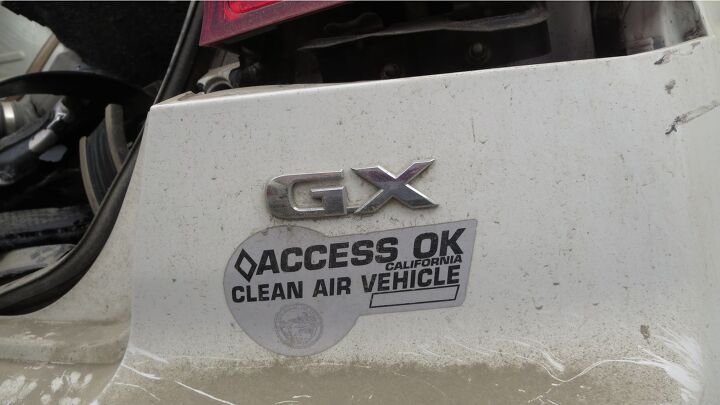274 Views
Junkyard Find: 2003 Honda Civic GX, CNG-fueled

by
Murilee Martin
(IC: employee)
Published: August 21st, 2017
Share
The compressed natural gas-burning Honda Civic GX first appeared in the United States in 1998, for sale to fleet buyers, but individuals in California were able to buy Civic GXs soon after that. In spite of its extremely clean tailpipe emissions, few Californians opted to endure the hassle of trying to refuel the GX, and so these cars are very rare sights in the Golden State.Here’s a crashed example I spotted a few weeks ago in a San Francisco Bay Area self-service wrecking yard.
The GX cost more and had less power than an ordinary gasoline-burning Civic, so there were two big reasons for Californians to buy one: to pollute less, and (probably more important to most) to be allowed to drive solo in the carpool lane (a huge inducement in a state that has the worst freeway congestion in the country).These days, you’ll see these decals all over the Bay Area, mostly on hybrid-electric and full-electric vehicles, but in 2003 there weren’t many Toyota Priuses and Honda Insights on the road and daily-driven EVs were nearly unheard of.
The D17A7 engine in the GX ran at higher compression than its gasoline-fed counterparts, thanks to the anti-detonation properties of CNG. In 2003, it generated 100 horsepower and drove the front wheels via a CVT. Not exciting to drive, but clean.
CNG is pretty cheap if you can find a filling station, so the per-mile cost to drive this car was a little bit cheaper than a gasoline Civic. CNG-powered vehicle drivers can install a home-refueling station that compresses household natural gas and puts it in the car’s tanks, so maybe that’s how the owner of this car rolled before the crash.
#2000s
#2003
#2003HondaCivic
#California
#Civic
#CivicCNG
#CivicNaturalGas
#CNG
#DownOnTheJunkyard
#Honda
#NaturalGas
#HondaCivic
#Junkyard
#JunkyardFind
#HondaCivicGx

Murilee Martin
Murilee Martin is the pen name of Phil Greden, a writer who has lived in Minnesota, California, Georgia and (now) Colorado. He has toiled at copywriting, technical writing, junkmail writing, fiction writing and now automotive writing. He has owned many terrible vehicles and some good ones. He spends a great deal of time in self-service junkyards. These days, he writes for publications including Autoweek, Autoblog, Hagerty, The Truth About Cars and Capital One.
More by Murilee Martin
Published August 21st, 2017 8:00 AM
Latest Car Reviews
Read moreLatest Product Reviews
Read moreRecent Comments
- MaintenanceCosts Poorly packaged, oddly proportioned small CUV with an unrefined hybrid powertrain and a luxury-market price? Who wouldn't want it?
- MaintenanceCosts Who knows whether it rides or handles acceptably or whether it chews up a set of tires in 5000 miles, but we definitely know it has a "mature stance."Sounds like JUST the kind of previous owner you'd want…
- 28-Cars-Later Nissan will be very fortunate to not be in the Japanese equivalent of Chapter 11 reorganization over the next 36 months, "getting rolling" is a luxury (also, I see what you did there).
- MaintenanceCosts RAM! RAM! RAM! ...... the child in the crosswalk that you can't see over the hood of this factory-lifted beast.
- 3-On-The-Tree Yes all the Older Land Cruiser’s and samurai’s have gone up here as well. I’ve taken both vehicle ps on some pretty rough roads exploring old mine shafts etc. I bought mine right before I deployed back in 08 and got it for $4000 and also bought another that is non running for parts, got a complete engine, drive train. The mice love it unfortunately.













































Comments
Join the conversation
CNG makes a lot of sense for a variety of things but it does have downsides versus regular petroleum cars. For trucks and buses, though, it's a complete win. The hybrid CNG-electric buses have cut emissions considerably in the state of Massachusetts and they're cheaper to run to boot.
That's gotta be the most optimistic speedometer I've ever seen. 150mph?